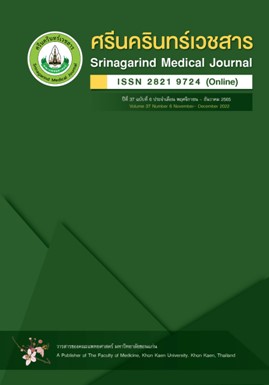การศึกษาประสิทธิภาพของการเคี้ยวหมากฝรั่งต่อการกระตุ้นการทำงานของลำไส้หลังการผ่าตัดคลอดบุตรทางหน้าท้อง โรงพยาบาลพุทธโสธร
Abstract
หลักการและวัตถุประสงค์: สตรีหลังผ่าตัดคลอดบุตรทางหน้าท้องจะมีภาวะลำไส้หยุดทำงานชั่วคราว การศึกษานี้มีวัตถุประสงค์เพื่อประเมินประสิทธิภาพของการเคี้ยวหมากฝรั่งต่อการกระตุ้นการทำงานของลำไส้ของสตรีหลังการผ่าตัดคลอดบุตรทางหน้าท้อง
วิธีการศึกษา: เป็นการศึกษาเชิงทดลองแบบสุ่มที่มีกลุ่มควบคุม กลุ่มตัวอย่างเป็นสตรีที่ได้รับการผ่าตัดคลอดบุตรทางหน้าท้อง จำนวน 60 ราย แบ่งเป็น 2 กลุ่มๆละ 30 ราย ได้แก่กลุ่มทดลองที่ให้เคี้ยวหมากฝรั่งหลังผ่าตัดคลอด และกลุ่มควบคุมที่ไม่ได้ให้เคี้ยวหมากฝรั่งหลังผ่าตัดคลอด บันทึกข้อมูลการทำงานของลำไส้ ได้แก่ การเคลื่อนไหวของลำไส้หลังผ่าตัดครั้งแรก การผายลมครั้งแรก และการขับถ่ายอุจจาระครั้งแรก
ผลการศึกษา: ระยะเวลาการได้ยินเสียงการเคลื่อนไหวของลำไส้ครั้งแรกในกลุ่มทดลอง (12.23±2.26 ชั่วโมง) เร็วกว่ากลุ่มควบคุม (13.86±1.96 ชั่วโมง) อย่างมีนัยสำคัญทางสถิติ (p = 0.004) (Mean difference 1.62, 95%CI 0.53-2.72) ระยะเวลาการผายลมครั้งแรกของกลุ่มทดลอง (24.38±3.62 ชั่วโมง) เร็วกว่ากลุ่มควบคุม (28.88±2.80 ชั่วโมง) อย่างมีนัยสำคัญทางสถิติ (p < 0.001) (Mean difference 4.50, 95%CI 2.83-6.17) ส่วนระยะเวลาการขับถ่ายอุจาระครั้งแรกของกลุ่มทดลอง (48.19±3.49 ชั่วโมง) และกลุ่มควบคุม (47.82±3.21 ชั่วโมง) ไม่แตกต่างกันอย่างมีนัยสำคัญทางสถิติ (Mean difference 0.37, 95%CI -2.10-1.36)
สรุป: สตรีหลังผ่าตัดคลอดบุตรทางหน้าท้องที่เคี้ยวหมากฝรั่ง มีระยะเวลาการเริ่มทำงานของลำไส้ เร็วกว่าสตรีหลังผ่าตัดคลอดบุตรทางหน้าท้องที่ไม่เคี้ยวหมากฝรั่ง
The Study of the Efficiency of Chewing Gum on Stimulation of Bowel Function after Cesarean Delivery at Buddhasothorn Hospital
Yuttana Chanwaro
Department of Obstetrics and Gynecology, Buddhasothorn Hospital, Chachoengsao
Background and objective: Pregnant women after cesarean delivery would have temporary ileus. This study aimed to assess the efficacy of gum chewing on stimulating bowel function in women after cesarean delivery.
Methods: This was a randomized control trial study. The representative samples were 60 pregnant women after cesarean delivery. They were randomly allocated to two groups: the gum chewing group (n=30) and the control group (n=30). The functional bowel informations such as the first bowel movement after cesarean delivery, first flatus, and first defecation were recorded.
Results: The duration of the first heard bowel movement of the gum chewing group (12.23±2.26 hours) was faster than the control group (13.86±1.96 hours) with statistical significance (p= 0.004), (Mean difference 1.62, 95%CI 0.53-2.72), the duration of the first flatus of the gum chewing group (24.38±3.62 hours) was faster than in the control group (28.88±2.80 hours) with statistical significance (p<0.001),(Mean difference 4.50, 95%CI 2.83-6.17). The duration of the first defecation of the gum chewing group (48.19±3.49 hours) and the control group (47.82±3.21 hours) was not statistically significantly difference (Mean difference 0.37, 95%CI -2.10-1.36).
Conclusion: Pregnant women after cesarean delivery who chew gum had the beginning bowel function faster than the pregnant women after cesarean delivery who did not chew gum.


